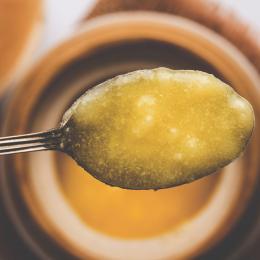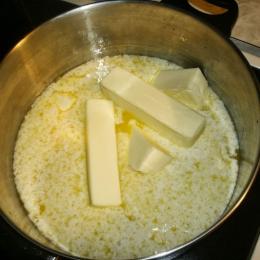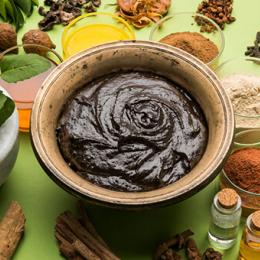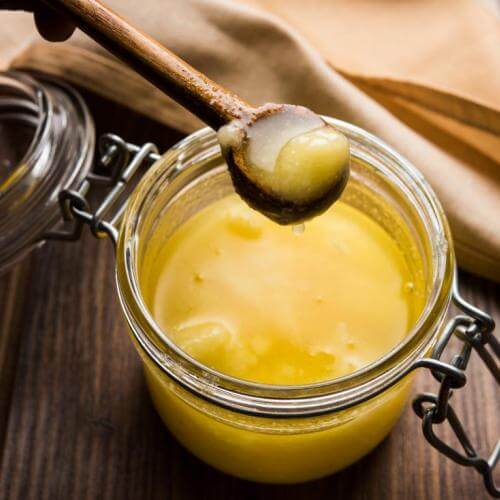
Ghee, is a Sanskrit term for rendered butter. In Sanskrit, ghee is known as ghrta - a word derived from the basis "ghr" which means "to shine". Transferred, this translation means the ability to connect body and mind. In India, ghee is often associated with the synonym "health elixir" due to its strong effect on the overall strengthening of the body, support of brain activity and prolongation of life.
The Difference Between Butter And Ghee
Ghee is formed by slowly heating unsalted butter. Thanks to heating, the individual components such as lactose, sugar and milk proteins in the form of foam begin to separate. After a while, all the water evaporates and the sugar and lactose are removed manually. So in the end we are left with only a clear golden liquid, a pure essence - ghee. It differs from classic butter mainly in its composition - it is almost 100% fat, while normal butter contains only about 83% fat and in addition water, whey or lactose. After this treatment, ghee is a suitable nutritional alternative for people with lactose intolerance. It should be mentioned that ghee retains all vitamins such as vitamins A, E and minerals such as potassium, magnesium and iron even after clarifying. It also contains butyric acid, protects the intestinal mucosa, has an anti-inflammatory effect, helps maintain insulin levels, lowers cholesterol, breaks down fats, promotes muscle growth and acts as a powerful antioxidant. Omega 3 and omega 6 fatty acids also act as nerve and brain tonics. The advantage of ghee is also that, unlike butter, it does not have to be stored in the cold. Due to the absence of water, which causes rancidity in the butter after a while, ghee can be used for months at room temperature. If one uses it externally as a skin care (especially in the case of dry skin), the older the ghee, the better.
Ghee in Ayurveda
We know from history that even 5,000 years ago, ancient Indian seers knew the beneficial effects of ghee on the support of body and mind. Ghee has long been considered one of the most important and beneficial means of Ayurveda. It is one of the most sattvic foods, known for its pure, harmonizing and uplifting nature. Sattvic foods promote physical strength, clear minds, good health and longevity. Therefore, ghee is often an integral part of traditional Ayurvedic recipes, purification and rasayana therapies, and Indian cultural practices.
The Sushruta Samhita states the following about ghee: “Ghrita is sweet, mild, soft, cold, greasy, does not increase moisture in body tissues, improves food movement in the digestive system, helps with colic and fever, relieves vata and pitta, increases kapha, nourishes dhatus and strengthens rejuvenation, stimulates memory and intelligence, has a beneficial effect on the skin, voice, beauty, softness, vitality, strength of life and longevity.
Ghee is used in Ayurvedic medicine as a medium, agent or conductor (anupana) for the preparation, use, direction and better absorption of the effects of traditional herbal preparations. Such a role is played by ghee even in the case of the most famous Ayurvedic "elixir of life" - Chyawanprash, a nutritional herbal jam composed of a unique combination of herbs, amalaki and ghee. It has been successfully prepared and used in India for 3,000 years, and you would find there many traditional producers who carefully guard their unique recipes and pass them on from generation to generation as family wealth. This is also the case with Chyawanprash, which we offer under our brand. Chyawanprash's antioxidant properties benefit gastrointestinal health, optimal functioning of the immune system and the complex vitality of the body tissues. We recommend taking 1-2 teaspoons in the morning and evening with a sip of lukewarm organic milk, vegetable milk or water. Ghee is an important part of many of our Ayurvedic herbal elixirs for deep regeneration according to the seven body tissues, as well as in the cleansing line of elixirs that are in charge of cleansing the body pathways. Due to their consistency, they represent excellent body nutrition and are fully compatible with Ayurvedic herbal teas. You can learn how to combine them effectively through our Ayurvedic health therapies, monthly recommendations according to the seasons and specific health problems.
Instructions for Preparing Ghee:
- Slowly dissolve quality unsalted butter with the highest possible fat content in a pot with a thick bottom, stirring occasionally.
- Cook the butter over a low heat for about 20-30 minutes. until all the water boils out of it.
- During cooking, foam from milk proteins, lactose and sugar forms on the surface, which we continuously collect with a spoon and put away.
- When a golden-brown deposit appears at the bottom, we set the pot out of the heat so that the butter does not burn.
- After collecting the foam and boiling the water out, a clear golden liquid remains in the pot with deposits on the bottom of the pot - ghee.
- Let it cool down a bit and drain the warm ghee through a canvas or filter into a prepared container made of thicker cooking glass or ceramic.

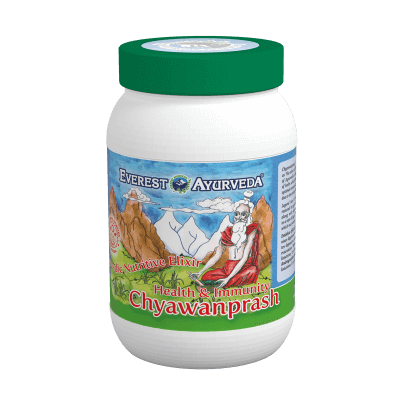 300 g
300 g 